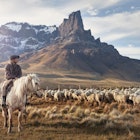
'One day I'll go back to these wonderful places' - How holiday photos make us feel more connected
May 19, 2020 • 5 min read

Holiday photos can make us feel more connected ©Getty Images/Westend61
A few weeks ago, Matt Haig, author of Reasons to Stay Alive, admitted to his Twitter followers that he had "an urge to see old holiday photos." In the same tweet he then asked if any of his followers had a picture from their “favourite holiday ever." Nearly 2000 people replied with snaps from around the world: an unflattering selfie at the Acropolis in Athens; a blurry Notre Dame de Paris at night; nuns enjoying ice-cream at the Trevi Fountain in Rome. Thoughtful, fun pictures from cherished travel memories.
- placement: fullWidth
- path: articles/in-content-top
- possible size: [970, 250], [970, 90], [728, 90], [300, 250], [320, 50], [1, 1],
- targeting:
{ "url": "the-power-of-travel-photos" }
What was most noticeable, though, was just how ‘normal’ the images looked. Filter-free moments captured for the primary purpose of remembering good, or in this case, better times. Haig's call to the past was a simple idea that has resonated with travel lovers currently forced to stay put.

Award-winning travel writer James Stewart remembers a photo taken on Christmas Day 1997 in Sydney. In it he’s playing an electric piano on the roof terrace of his former apartment near Bondi Beach. "It's an image of sunshine, joy and friendship. It speaks of a free life, one of vertiginous possibilities – it was also the last hurrah of my time in Sydney," James tells Lonely Planet. “Holiday snaps fill in the details – the faces, the crumbling walls, the intense heat – that can bring past travels right back into the now.”

But is it a good idea to look at – and then long for – the past? The perceived idea on these things, via many a modern mindful lens, is that looking back or, indeed, forward can be damaging. 'The power of now is almighty,' we cry; a way to reduce negative feelings in one attention-focusing swoop. Stewart’s thinking seems to align: “If reviving memories of happy times in foreign places sustains you, then knock yourself out. Personally, they just stoke my yearning to get away after weeks in lockdown. Since travel is verboten I'd prefer to live in the here and now.”
- placement: fullWidth
- path: articles/in-content-middle
- possible size: [970, 250], [970, 90], [728, 90], [300, 250], [320, 50], [1, 1],
- targeting:
{ "url": "the-power-of-travel-photos" }

But what about when the present is tough? The response to Matt Haig’s tweet seems to suggest that, for some, looking back can make the ‘now’ a bit more bearable. Dr Tim Wildschut, professor of psychology at the University of Southampton specialises in nostalgia and argues – in a peer reviewed paper – that nostalgia is a predominantly positive force. “It can serve to offset or counteract the negative effects of distressing psychological states, such as loneliness and social isolation, by fostering a sense of social connectedness,” he says.
Photos and the memories they contain can be a punchy trigger for nostalgia. Dr Krystine Bacho, a professor of psychology at Le Moyne College in Syracuse, New York, agrees: “Photos can revive a sense that things can be good again, while inspiring us to contact an old friend and share memories with others. Posting photos and asking if others also ‘remember when’ helps us feel connected and less alone.”

Joe Bindloss has been writing Lonely Planet guides to Southeast Asia, Africa, Europe and Australia for more than 20 years. The photo that inspires one of his richest memories was taken at an altitude of 5,240m. “I’m always transported by this photo of fresh snow on the Cho La pass, looking towards Ama Dablam in Solukhumbu,” he says. “Minutes later, as I crossed the pass, a blizzard swept across the valley, with snow so heavy I could hardly see the path in front of me. I walked for hours through this whiteout before finally stumbling into Gokyo just before sunset for a plate of dal bhat and a hot cup of salt-butter tea – a visceral, life-affirming experience.”
Bindloss feels “powerfully attached” to the snaps of his first trek in Nepal, not because they’re great photos, but because they remind him of how it felt to be footloose and carefree. Recently, he has found it grounding to look back on “old travel” – in particular, photos from his Lonely Planet guidebook research on Sri Lanka and Penang in Malaysia. “I remind myself that the world is still completely amazing, and that one day, I'll go back to these wonderful places around the world.”
- placement: native
- path: articles/in-content-native
- possible size: [f, l],
- targeting:
{ "url": "the-power-of-travel-photos" }

For many, nostalgia-inducing memories are now snapped and stored on social media apps. Dr Bacho thinks Instagram can also be beneficial: “Social media has added a layer of immersion in the past. For example, watching a video revives the past in a richer way than just looking at still photos.”
Travel writer and influencer Chris Watts sees Instagram’s convenience and accessibility as its primary benefit: “All your photos at the touch of a button; it’s like having a passport in your pocket – it can take you anywhere in a second.” A sense of freedom at a time when one’s movements are restricted.
But is having something physical, a photo you can hold in your hand, a greater aid to conjuring positive memories? That may well be in the eyes and hands of the beholder, but Dr Bacho recognises that, “Like antiques and souvenirs, old photos provide a more direct, concrete connection to the past, for which there might be no substitute. We are physical beings and feel most alive when we interact with the important parts of our material world.” Bindloss is inclined to agree, likening the Instagram experience to popcorn vs the “eight course dinner provided by an old-fashioned photo album”.
The argument as to the difference in nostalgic value between the two mediums must also extend to the motivation behind the respective photographs’ creation. What’s noticeable about the images posted in response to Haig’s Twitter question is that they have the same unvarnished quality as the old printed photos that Bindloss describes.
You may also like:
Step up your Instagram game with these 10 travel photography tips
How to organize your travel photos in four steps
Nikon is offering free photography classes online
- placement: fullWidth
- path: articles/bottom
- possible size: [970, 250], [970, 90], [728, 90], [300, 250], [320, 50], [1, 1],
- targeting:
{ "url": "the-power-of-travel-photos" }
Explore related stories

Photography
8 places to see tigers in the wild – and how to make it happen in 2024Apr 16, 2024 • 13 min read

 National ParksSafari animals: the story of rhinos and the best places to see them in 2022
National ParksSafari animals: the story of rhinos and the best places to see them in 2022Aug 16, 2022 • 6 min read
 BeachesSydney was everything I remembered and more: returning to Australia after two years of longing
BeachesSydney was everything I remembered and more: returning to Australia after two years of longingJun 29, 2022 • 6 min read
 PhotographyUnderwater photography contest captures astonishing scenes of animal behavior
PhotographyUnderwater photography contest captures astonishing scenes of animal behaviorJan 15, 2021 • 1 min read
 PhotographyThese award-winning images show the challenges facing our natural world
PhotographyThese award-winning images show the challenges facing our natural worldOct 16, 2020 • 4 min read
 Digital NomadSee the incredible photos of remote African tribes captured by a COVID frontline nurse
Digital NomadSee the incredible photos of remote African tribes captured by a COVID frontline nurseAug 4, 2020 • 4 min read
 Wildlife & Nature"New Big 5" project wants to change how we think about wildlife conservation
Wildlife & Nature"New Big 5" project wants to change how we think about wildlife conservationMay 13, 2020 • 3 min read

 Digital NomadDream job alert: travel and earn £80k next year with this photography job
Digital NomadDream job alert: travel and earn £80k next year with this photography jobDec 10, 2018 • 2 min read
